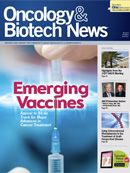Publication
Article
Oncology & Biotech News
Studies Find That Talc-Based Powder Increases the Risk of Ovarian Cancer
Author(s):
Long-term use of talc-based powder significantly increased the risk of invasive ovarian cancer in a large case-control study

Long-term use of talc-based powder significantly increased the risk of invasive ovarian cancer in a large case-control study. Overall, talc use increased ovarian cancer risk by about 30%; however, the risk increased by three- to fourfold among women reporting long-term, frequent use of talc powder.
“I have always advised gynecologists [that] if they examine a woman and see that she is using talc in the vaginal area, tell her to stop,” said Daniel W. Cramer, MD, a gynecologic oncologist at Brigham and Women’s Hospital in Boston, Massachusetts, in an interview at the AACR meeting. “There are alternatives, such as cornstarch-based powder. This study strongly reinforces that advice.”
Results of more than 20 epidemiologic studies have supported an association between use of talc-based powder and ovarian cancer, but the studies did not provide evidence of a dose-response relationship, said Cramer.
The biologic explanation for the association also has been questioned. Cramer speculated that the association involves upregulation of heat shock proteins, mucins, and other molecules that predispose to chronic inflammation. Inadequate cleansing after use of talc might allow the powder to migrate into the lower genital tract and initiate an inflammatory reaction. In support of that view, he noted that talc particles have been found in lymph nodes and other tissues of ovarian cancer patients.

Daniel W. Cramer, MD
Evidence of a dose-response relationship came from an analysis of a case-control study involving more than 2000 women with ovarian cancer and a similar number of women without the cancer. The history of talc use predated ovarian cancer diagnosis by at least a year. Investigators estimated each patient’s total number of talc applications from self-reported frequency and duration of use.
Investigators analyzed the data for all cases of ovarian cancer, irrespective of histology, and for the subgroups of patients with nonmucinous invasive cancer, serous invasive cancer, and serous invasive cancer exclusive of 23 www.OncLive.com Jewish ancestry or family history. Adjustment for baseline imbalances and confounders included age, parity, oral contraceptive use, tubal ligation, body mass index, smoking, alcohol use, Jewish ethnicity, and family history of breast or ovarian cancer.
All of the analyses showed that talc use increased the risk of ovarian cancer by 20% to 40%, but most often by about 30%. The analyses showed statistically significant differences for all study participants and for postmenopausal women (who accounted for 60% of the study participants), but not premenopausal women.
"I have always advised gynecologists [that] if they examine a woman and see that she is using talc in the vaginal area, tell her to stop."
—Daniel W. Cramer, MD
Dose-response associations derived from estimated total talc applications yielded significant trends for all women (P = .002), premenopausal women (P = .05), and postmenopausal women (P = .02). The ovarian cancer risk increased dramatically in certain subgroups. For example, premenopausal women who reported long-term, frequent use of talc had a 3.5-fold excess risk for serous invasive ovarian cancer after exclusion of women of Jewish ancestry or with a positive family history. The significant trend for a dose-response relationship remained whether the analyses included women reporting no talc use or excluded them (P = .001)










